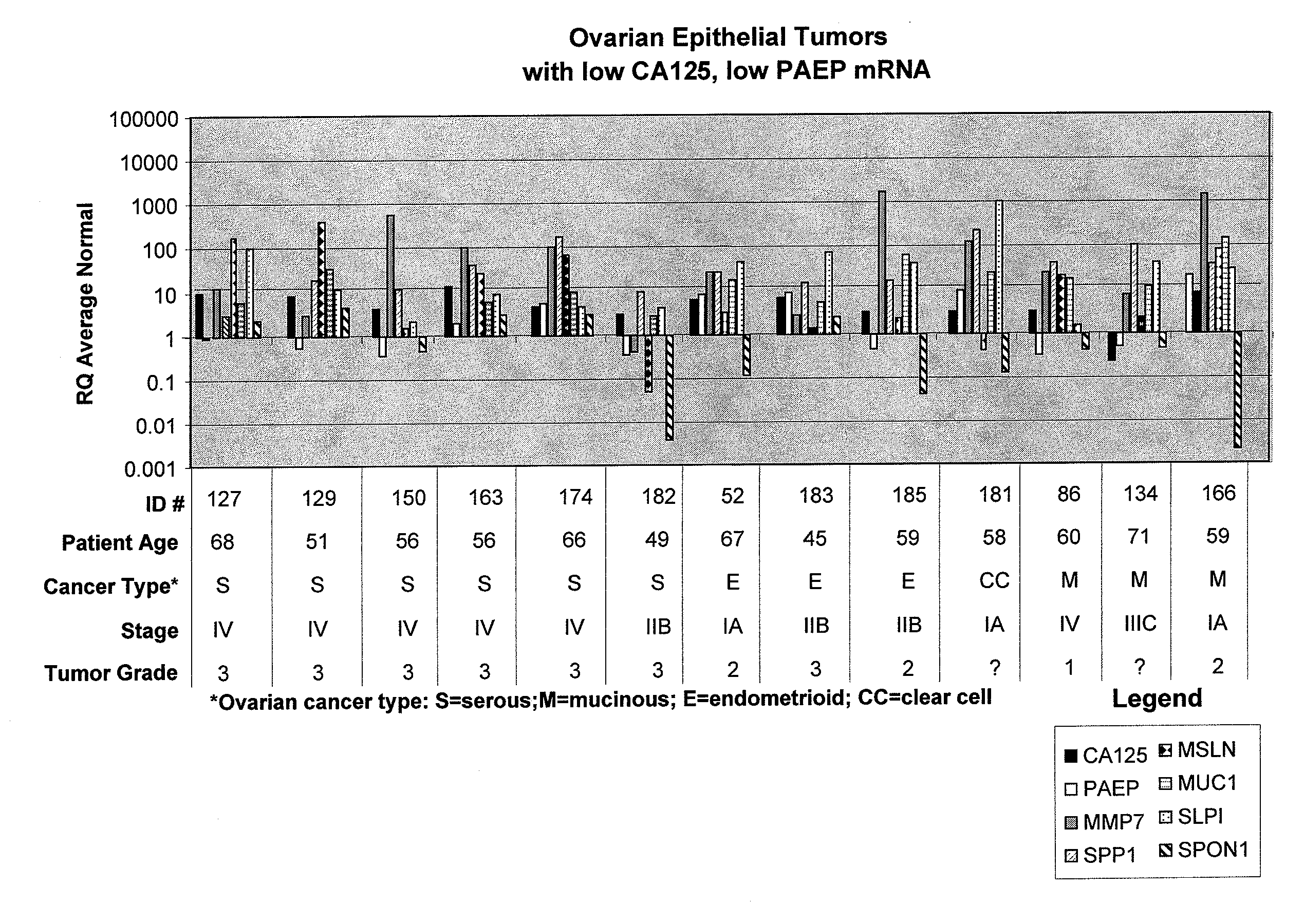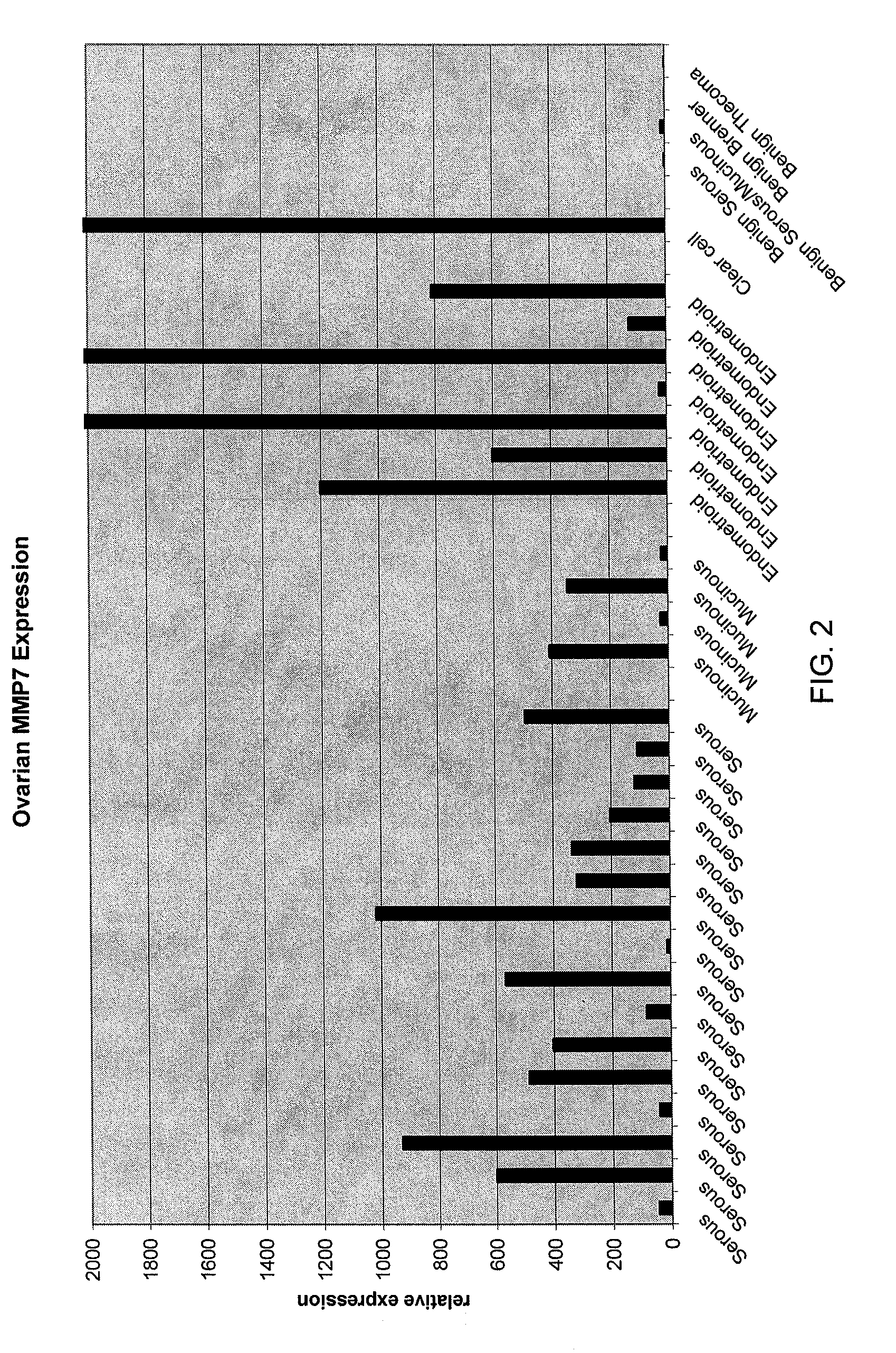Nucleic acid-based methods and compositions for the detection of ovarian cancer
a technology of ovarian cancer and nucleic acid, applied in the direction of microorganism testing/measurement, biochemistry apparatus and processes, etc., can solve the problems of insufficient specificity of the method for use as a general screening method, and the inability to detect ovarian cancer in time. to achieve the effect of facilitating the diagnosis of early-stage ovarian cancer
- Summary
- Abstract
- Description
- Claims
- Application Information
AI Technical Summary
Benefits of technology
Problems solved by technology
Method used
Image
Examples
example 1
Real-Time PCR Detection of Nucleic Acid Biomarkers in Clinical Ovarian Tissue Samples (Biomarker Group 1)
Ovarian Tissue Samples
[0077]Normal and cancerous ovarian tissue samples were obtained from Proteogenex (Culver City, Calif.). A total of 42 frozen tissue specimens were analyzed along with three RNA preparations purchased from commercial suppliers. Normal ovarian and cancerous ovarian RNAs were purchased from Ambion, Inc. (Austin, Tex.) or from Stratagene (La Jolla, Calif.). The specimens analyzed consisted of 13 normal, 28 cancerous, and 4 benign ovary tissues. The cancerous tissues consisted of the following types of epithelial tumors: 16 serous, 4 mucinous, 7 endometrioid, and 1 clear cell. Thirty-nine of the frozen tissue specimens were accompanied by matched formalin-fixed, paraffin-embedded (FFPE) samples that were also analyzed.
RNA Purification
[0078]Total RNA was purified from snap frozen tissue specimens using the QIAGEN RNeasy Mini Kit (QIAGEN, Inc., Valencia, Calif.) ac...
example 2
Real-Time PCR Detection of Nucleic Acid Biomarkers in Clinical Ovarian Tissue Samples (Biomarker Group 2)
Ovarian Tissue Samples
[0098]Normal, benign, and cancerous ovarian tissue samples (n=94) were analyzed for expression levels of various biomarkers, as described herein below. The specimens analyzed consisted of 22 normal ovarian tissue samples, 68 epithelial ovarian tumors, and 4 benign ovarian masses. The cancerous tissues consisted of the following types of ovarian epithelial tumors: 40 serous, 7 mucinous, 17 endometrioid, and 4 clear cell ovarian carcinomas.
Detection of Expression Levels—Real-Time PCR Analysis
[0099]mRNA from each of the above ovarian tissue samples was extracted and TaqMan® real-time PCR was performed as described in Example 1 to determine biomarker mRNA levels. The primers and probes for the ovarian cancer nucleic acid biomarkers were purchased from Applied Biosystems either as pre-designed TaqMan® Gene Expression Assays or as custom syntheses. Custom primers ...
PUM
| Property | Measurement | Unit |
|---|---|---|
| diameter | aaaaa | aaaaa |
| diameter | aaaaa | aaaaa |
| molecular weight | aaaaa | aaaaa |
Abstract
Description
Claims
Application Information
 Login to View More
Login to View More - R&D
- Intellectual Property
- Life Sciences
- Materials
- Tech Scout
- Unparalleled Data Quality
- Higher Quality Content
- 60% Fewer Hallucinations
Browse by: Latest US Patents, China's latest patents, Technical Efficacy Thesaurus, Application Domain, Technology Topic, Popular Technical Reports.
© 2025 PatSnap. All rights reserved.Legal|Privacy policy|Modern Slavery Act Transparency Statement|Sitemap|About US| Contact US: help@patsnap.com



